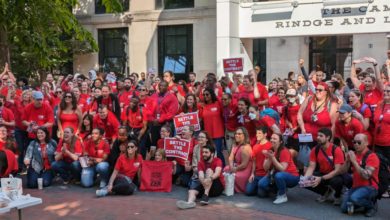Roughly one hundred people gathered on Boston Commons on March 1 to rally around Boston Public Schools and students who walked out in defense of public education in the city against the racism, sexism, homophobia, transphobia, ableism and anti-immigrant measures of the Trump administration. March 1 was declared a National Student Day of Resistance and the rally on the Commons was one of several student demonstrations held in Boston that day.
Students walked out of their classrooms around noon and gathered with other student supporters at the Parkman Bandstand in the Boston Commons by 1:00 pm. The action was organized by the Coalition Against Student Apathy, a student organization based largely at Boston Latin Academy. Members of the community turned out in solidarity, including a large group from local Suffolk University and students from other colleges in the greater Boston area. Several members of the Coalition to Organize and Mobilize Boston Against Trump also came out to show their support.
CASA arrived leading a contingent waving signs, flags, and banners in support of public education, which were displayed from the gazebo. A speakout commenced with students and supporters chanting, “No more cutbacks, no more rules, no more greedy corporate tools,” “My education, not your money,” “Whose schools? Our schools, ” “Betsy DeVos has got to go” and “No Trump, no KKK, no fascist, racist USA!”
Organizers distributed sheets listing “Next Steps” that urged protesters to pressure their representatives, join political organizations, and attend upcoming demonstrations in support of the Standing Rock Sioux (March 10), Planned Parenthood (March 4), and for Science and Truth (April 22). The sheets also listed contact information for CASA and COMBAT.
After the speakout, the students and their supporters marched from the Parkman Bandstand to the Massachusetts State House, where they occupied the front steps by Beacon Street and spilled out onto the sidewalk, displaying a banner that read “Student Power” and “School the Administration–CASA.”
The protesters left the State House around 1:45 pm to march down Beacon Street and then to School Street, with their chants echoing off the tall buildings and amplified by the narrow downtown avenues. After another round of speeches, the action ended near 2:30 pm, back on Boston Commons.
Cutbacks and bigotry from above; protest and organizing from below
The walkout was the latest in a series of actions organized by public school students. Before last year’s presidential election, the walkouts focused mainly on budget cuts to Boston Public Schools, but this action took greater notice of national political developments.
Many students demanded the resignation of the Secretary of Education, Betsy DeVos, denouncing her support for allowing guns in schools and for privatization measures that threaten the quality of public education — especially for students with disabilities or from working or racially oppressed families — and prioritize private profits.
Linking national and local politics, other students pledged to fight against the normalization of harmful language and ideas, and in defense of friends, classmates, and others from oppressed communities. Several students spoke to feeling unsafe and attacked by their government in their own schools due to President Trump’s blatant contempt and hatred for disabled, undocumented, and LGBTQ people.
A Black student from CASA noted her access to public education with a shirt printed, “I am my ancestors’ wildest dream”– a legacy of struggle, she warned, now threatened by Trump’s white supremacist movement and Betsy Devos’s program to dismember public education.
Several other students also emphasized the immediate need to protect themselves against attempts to defund public education. That many students skipped class to bolster the walkout demonstrated the depth of their commitment to the cause.
Student organizers and supporters were united in emphasizing the grassroots character of the action and of the wider movement of student resistance. It was “street organizing,” an example of the kind of “local protests” that historically have driven the most social change. As a pair of students in the crowd discussed how to grow the movement in the coming months, the message of an earlier chant resonated: “Ain’t no power like the power of the students, ’cause the power of the students don’t stop!” ”






